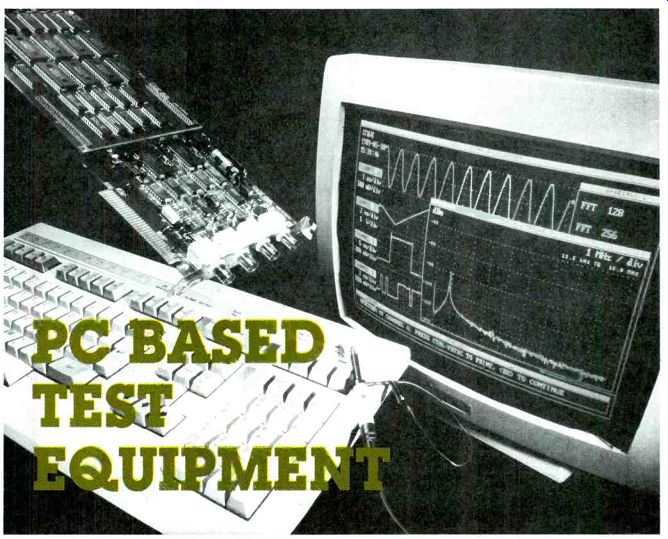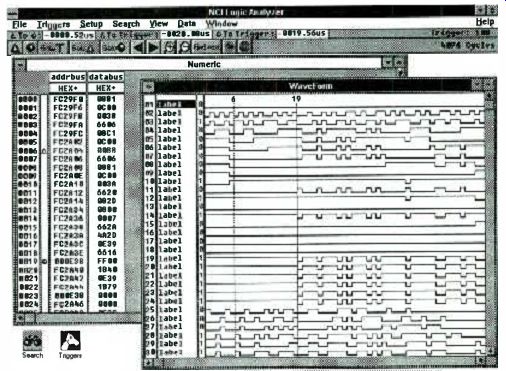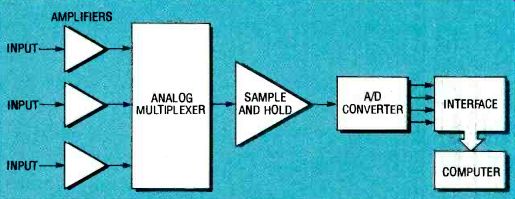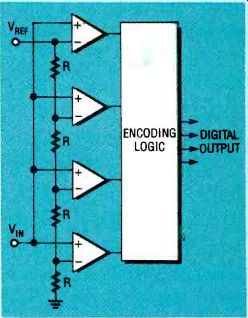Boards that plug into computers are attractive alternatives to conventional instruments for many test and measurement applications.
by TJ BYERS

IT IS DIFFICULT TO FIND ANY HUMAN activity today that hasn't been drastically changed by the personal computer. The PC has had a dramatic impact on the industrial test and measurement field, where PC-controlled automated test equipment and instrument clusters are now reported to outnumber standalone instruments.
PC-based instruments are fundamentally plug-in circuit boards supported by appropriate applications software that permit the computer to take on the functions that were formerly those of stand-alone electronic test measurement instruments. Most PC instrument circuit boards plug into ISA-bus (Industry Standard Architecture) slots in IBM-PC /AT computers or compatibles, generally, but not exclusively, desktop models.
Early sales of PC-based test instruments never reached expectations because they were mistakenly targeted as direct replacements for benchtop, stand-alone instruments. Because PC-based instruments operate in the digital domain and require that analog input signals be first converted to digital signals, they can't respond in real time as rapidly as, for example, a permanent magnet, moving-coil meter movement.
It takes a finite amount of time to digitize and process the data, which puts PC-based instruments at a disadvantage in performing and displaying real-time measurements. Add to that the cost of analog–to-digital conversion electronics. This reason alone ruled out the possibility that PC-based instruments would ever be direct replacements for most standard test instruments.
-------------

A BACKPLANE ENCLOSURE THAT ACCEPTS MANY PC-BASED INSTRUMENT and overcomes noise and interference problems inherent in desktop computers. Rapid Systems' PCXI includes 7 to 13 ISA or EISA slots and a 200-watt power supply.
However, PC instrument advocates, typically software and hardware vendors, finally convinced the industry that PC-based test equipment's real strength is in its versatility and flexibility-it can respond rapidly to changing test situations. Because it is PC-based, its characteristics can be readily changed with software.
In addition, several PC-based instruments can be linked together to form an instrument console or automated test equipment (ATE) station. A single computer enclosure can hold more test instruments in the form of plug-in boards than a workbench full of conventional instruments. This feature saves space and improves test and measurement productivity. Moreover, PC-based instruments, unlike the conventional instruments, can log data automatically and store it for delayed processing.
Surveying the market
Personal computer plug-in boards fall into two categories: controller /interface (mostly those conforming to the IEEE-488 standard), and analog/digital signal processing.
The IEEE-488 bus, widely known as the General Purpose Interface Bus (GPIB), is a digital system that permits up to 15 instruments or devices to communicate with each other. It's primary purpose is to integrate conventional dedicated instruments from the same or different vendors. For example, an oscilloscope from Hewlett-Packard can be integrated with a signal generator from Tektronix into an instrument cluster. Unfortunately, the data transfer rate between connected and properly interfaced instruments is quite slow, usually less than 20 kilobytes per second.
Plug-in signal processing boards have the speed and power to meet many of the latest demands for high-speed automated testing. In the time it takes a GPIB-interfaced device to acknowledge a request to send, a PC-based digital sampling oscilloscope can log 1000 measurements. These boards are sold as either general-purpose data converters for analog-to-digital or digital-to-analog conversion, or as instrument-specific boards that emulate such functions as an oscilloscope or frequency counter.
The only difference between the two kinds of boards is that instrument-specific boards are sold with software that automatically makes the adapter card look and act like a conventional benchtop instrument.
Some plug-in boards perform functions that cannot be performed by conventional instruments, yet others offer superior performance at lower cost. A prime example is Guide Technology's GT65O time interval analyzer. It costs less than half the price of a comparable time-interval analyzer from Hewlett-Packard, yet provides 2000 times the memory and 50 times the throughput. However, this particular specification might not take into account all of the differences in performance or features that would govern a specific purchase.
General-purpose digital signal processing boards offer high performance, but the user must write his own program or buy it from a software vendor such as Hyperception. There is a lot to be said for creating your own PC-based instruments because certain qualities can be emphasized. This is especially true if the user is constrained by specific price or performance goals.
For example, when a Spectrum Signal Processing analog-to-digital converter board with 16-bit resolution and a sampling rate of 153 kilo-samples per second is paired with Hyperception's AMPS Windows software program, the combination can emulate four different instruments: High-speed digital storage oscilloscope Fast Fourier Transform (FFT) spectrum analyzer Programmable digital filter Digital chart recorder Alternatively, you can elect to save money and buy Keithley Metra-Byte's DAS-1200 ADC board with Quick-BASIC support. It can create a 16-trace digital storage oscilloscope or digital chart recorder for only $449. The company says its product is suitable for multimedia applications.
PC-based instruments can be expensive when compared with their conventional counterparts. They could cost nearly three times as much as the stand-alone instrument. But when you cluster a number of instrument boards in a single computer enclosure, or configure one data converter board for multiple functions, pricing can favor the PC-based setup. As with any buying decision, you must shop wisely. The following is an overview of a selection o available PC-based test instruments with a commentary on what to look for when buying each one.
Digital sampling oscilloscope
The most popular PC-based test instrument is the digital sampling oscilloscope because it has the widest range of applications, and it takes advantage of the computer monitor's large display screen. These instruments are available from most PC instrument vendors, and they range in price from $595 to over $7000. The core of the PC-based oscilloscope is the analog-to-digital converter (ADC). The resolution of the sampled input is determined by the number o ADC bits, which typically range from 8 to 16. On-board random access memory (RAM) initially captures the sampled wave form. As the on-board RAM is used, the computer moves the data from the on-board RAM to its system memory, where it is processed by the video circuitry for display on the monitor.
The amount of RAM deter mines the length of the wave form that can be captured. A high sampling rates, the memo is used very quickly. So make sure that the system you specify will not only sample as fast as required (see the sidebar-Analog-To-Digital, and Back Again) but also for as long as required To avoid loosing data from memory overflow, captured waveforms can be stored on hard disk with special software programs called streamers.
Most PC-based multi-channel oscilloscopes consist of a single channel, analog–to-digital converter (ADC) and an input multiplexer, as shown in Fig. 1. The multiplexer time shares the in put signals by allowing each o them to be sampled independently. To find the maximum sample rate per channel, the sampling rate of the ADC must be divided by the number o channels sampled. For example if an eight-channel board has performance specification of 1 mega-sample per second, each of the eight channels would have a sample rate of only 125 kilo-samples per second.
The maximum sample rate might be specified with all channels set at the same gain.
Changing the gain from channel to channel can slow the overall sampling rate.
One of the fastest PC-based digital oscilloscope boards available is Signatec's DA5OO. It has a sample rate of 500 mega-samples per second, a 350-MHz bandwidth, and is sold with 256 kilobits of RAM that can be expanded to 32 megabits.
At $595, the Compu-Scope LITE from Gage Applied Sciences seems to be the lowest cost digital oscilloscope board available. It offers a 40 mega-sample per second rate, a 7MHz bandwidth, and is sold with 16 kilobits of RAM that is expandable to 64 kilobits.
-------------

PC-BASED TEST INSTRUMENT BOARDS such as CompuScope's 220 plug into any ISA or EISA PC expansion slot.

PC-BASED INSTRUMENTS USE Windows 3.1. An example is NCI's PA485 logic analyzer. Its operating screen is shown here.
------------
Spectrum analyzer
Another common PC-based instrument is a spectrum analyzer that examines the frequency domain of the acquired input data. The PC-based version makes frequency domain measurements with the fast Fourier transform (FFT) technique. It digitally processes a signal over a specific period of time to provide frequency, amplitude, and phase information.
It can analyze periodic and nonperiodic signals.
Unlike the most common swept-spectrum or superheterodyne spectrum analyzer architecture, the FFT architecture can display the data in a large number of formats. These include rectangular, triangular, exponential, and extended cosine bell plus the classical Kaiser-Bessel and Hamming formats.
Most PC-based FFT spectrum analyzers process the data collected by a digital sampling oscilloscope through an FFT software program. The price of the FFT software varies according to manufacturer and display options, but can cover the rather wide range of $100 to $1000. While each program is dedicated to the PC board for which it is written, one can purchase software packages from vendors such as Geotest and Hyperception that support a variety of boards from different vendors.
The FFT calculations are done by the PC's CPU, so the faster the processor, the faster the data throughput. In some cases, installing a math coprocessor chip, such as an Intel 287 or 387, can improve throughput up to 10 fold. However, Intel's 486 processor with its built-in math coprocessor dramatically reduces calculation time.
-----------------

ANALOG-TO-DIGITAL AND RETURN
The heart of all PC-based test instruments is either an analog-to-digital or digital-to-analog converter--ADC or DAC. Some products have both of those functions on the same board, or built within the same function.
Central to the operation of an ADC is a clock that generates pulses to drive the conversion electronics. The time taken to perform one complete conversion cycle in an ADC is called the sampling rate, and it is usually specified in kilo-samples per second or mega-samples per second.

FIG. 2--SUCCESSIVE APPROXIMATION analog-to-digital converter block
diagram.

FIG. 3--BLOCK DIAGRAM OF A FLASH analog-to-digital converter.

FIG.1--MULTI-CHANNEL PC-BASED instruments include a single A/D converter
and an input multiplexer that switches each channel.
General sampling theory-commonly referred to as the Nyquist theorem states that the minimum sampling rate must be at least twice as fast as the highest frequency component in the input or output signal being sampled. To sample a 2-MHz sinewave, for example, the sampling rate must be at least 4 mega-samples.
The maximum sample rate for a board depends on its ADC. There are three principal circuit architectures for converting analog signals to the digital output that the computer needs to process the data: dual-slope, successive approximation, and flash conversion. Of these, only successive approximation and flash converters can perform the enough for instrumentation emulation.
A successive approximation (SA) converter consists of a comparator, a DAC, and successive approximation counter and logic as shown in Fig. 2.
The analog input signal is first buffered and conditioned by the comparator. The converter compares an unknown analog voltage against a group of weighted references in a process that is analogous to the weighing of an unknown quantity on a precision balance.
In that process a set of weights in descending order of value is tried, starting with the largest. Any weight that tips the scale is removed. At the of the process when balance is achieved, the sum of the weights remaining on the scale represents the unknown value.
Similarly, after successive stepping, the successive approximation DAC's digital output equals the unknown input voltage. A ten-bit SA converter, for example, can make 10-bit conversions of an unknown voltage in less than 20 microseconds.
A flash converter is an ADC for high-speed, high-resolution conversion. As shown in the simplified block diagram Fig. 3, it consists of a parallel array of voltage comparators, a weighted resistor network, and encoding logic. It performs analog-to-digital conversion with one comparator for each possible level, and it feeds the input signal to all comparators. The digital output is taken from the encoding logic. Flash converters require 2n-1 comparators for an n-bit binary word.
The SA DAC take more time to settle on a digital output value than the flash converter. However, an SA DAC, in integrated circuit form costs less than a flash converter DAC IC, so now it is the DAC most widely used in the present generation of PC-based instruments.
--------------------
WHERE TO BUY
Gage Applied Sciences, Inc.
465 Vanden Abeele Montreal, Quebec Canada H4S 1S1
(514) 337-6893
Geotest
8242 West McDurmott St. Suite A
Irvine, CA 92714 (714) 263-2222
Guide Technology Inc.
20 Saratoga Ave.
Suite 215 an Jose, CA 95129 (408) 246-9905
Hypercecption
9550 Skillman LB 125
Dallas, TX 75243 (214) 343-8525
Keithley Metrabyte Corp.
40 Myles Standish Blvd.
Taunton, MA 02780
(508) 880-3000
NCI 438 University Dr.
Huntsville, AL 35806
(205) 837-6667
Optoelectronics Inc.
821 NE 14th Ave.
Fort Lauderdale, FL 33334
(800) 327-5912
Quatech, Inc.
662 Wolf Ledges Pkwy.
Akron, OH 44311 216) 434-3154
R.C. Electronics Inc.
6464 Hollister Ave.
Goleta, CA 93117 805) 685-7770
Rapid Systems Inc.
4307 Leary Way NW
Seattle, WA 98107
(206) 784-4311
Signatec, Inc.
357 Sheridan St. No. 119
Corona, CA 91720
(714) 734-3001
Spectrum Signal Processing Inc.
100 Production Ct.
8525 Baxter Pl.
Burnaby, BC V5A 4V7
(604) 421-5422
-------------------------
Nevertheless, there are test situations in which even a 486-based PC with an FFT board isn't fast enough. This can occur when more than one channel of data is being processed.
However, adding a digital signal processor (DSP) integrated circuit to the ADC board can improve FFT throughput. By moving the FFT calculations from the computer to the DSP device, and Hamming formats.
Most PC -based FFT spectrum analyzers process the data collected by a digital sampling oscilloscope through an FFT software program. The price of the FFT software varies according to manufacturer and display options, but can cover the rather wide range of $100 to $1000. While each program is dedicated to the PC board for which it is written, one can purchase software packages from vendors such as Geotest and Hyperception that support a variety of boards from different vendors.
The FFT calculations are done by the PC's CPU, so the faster the processor, the faster the data throughput. In some cases, installing a math coprocessor chip, such as an Intel 287 or 387, can improve throughput up to 10 fold. However, Intel's 486 processor with its built-in math coprocessor dramatically reduces calculation time.
Nevertheless, there are test situations in which even a 486-based PC with an FFT board isn't fast enough. This can occur when more than one channel of data is being processed.
However, adding a digital signal processor (DSP) integrated circuit to the ADC board can improve FFT throughput. By moving the FFT calculations from the computer to the DSP device, … the CPU is relieved of a heavy burden, giving it more time for other tasks.
Here again, Gage Applied Sciences seems to be offering the lowest-priced plug-in FFT spectrum analyzer. It costs only $100 more to add 1024-point FFT capabilities to the company's $595 Compu-Scope LITE digital oscilloscope board.
The most impressive FFT software program is VIEWDAC, distributed by Keithley MetraByte. This 32-bit Windows-based program is compatible with a large number of different PC boards from several vendors. It can execute a 25,000-point FFT in less than 25 seconds, and run through an FFT of 1024 points in just 57.7 milliseconds.
----------------------------
PC-BASED TEST INSTRUMENTS GO PORTABLE
Not all PC-based test instruments are anchored to the electronic workbench. They are just as much at home in the field as their conventional counterparts-and a lot more versatile. Many PC-based boards, such as Optoelectronics PC10 Universal Frequency Counter, are sized to fit the current crop of laptop personal computers.
The 9-inch PC10 card easily fits in many PC /XT half-length slots, weighs under 6 ounces, and consumes just 2 watts of power. Moreover, this $335 board outperforms many handheld counters that cost ten times as much. It measures frequencies from sub-audio to 2.4 GHz with 10 millivolt sensitivity and 10-digit resolution. It also does something no portable counter can--It can save the data to disk for later study and analysis.
------------------
Signal generator
It would be hard to find a test lab or ATE setup that does not have a reliable, accurate signal generator. That instrument provides the test signals needed to "shake down" new designs or do quality assurance testing on parts in production.
Signal generators are based on three architectures: function, arbitrary, and pulse. The simplest is the function generator that can deliver sine, square, triangular, or pulse waveforms over a wide range of frequencies. An arbitrary generator allows the waveshape to be defined by plotting it on a grid, dot by dot, so it can be repeated as many times as desired. A pulse generator provides transistor-transistor logic (TTL) compatible signals of varying widths and repetition rates.
All PC-based signal generators have a core of a digital-to-analog converter (DAC). Regardless of the shape of the waveform, each point is defined by a binary quantity that the DAC converts to an analog voltage. Normally, the waveform is stored in on-board RAM. The amount of RAM needed increases directly with the complexity of the waveform and the number of resolution bits.
Arbitrary waveform generators are versatile because some can fill all three requirements, but they cost no more than a comparable function or pulse generator. They carry an average price of bout $1300. However, good arbitrary waveform generators are available for less than $1000. Frequency Counter
The universal frequency counter is reported to be losing sales to the versatile digital sampling oscilloscope, which can also display frequency and time measurements as well as waveforms. But recent advances in counter technology have resulted in new class of instruments called time-interval analyzers. Like a sampling oscilloscope, a time interval analyzer samples a small "window" of information and stores it for display or analysis. However, the counter characterizes the dynamic variation of time intervals or frequency, rather than the dynamic variation of the voltage.
A typical time-interval analyzer application is in the demodulation of an FM signal in near-real time. A significant advantage of this technique is attributable to its extraordinary dynamic range of more than 1000:1-while maintaining a high 1 part per million (ppm) resolution.
As with any sampling measurement, the counter must sample data at a rate sufficient to satisfy the Nyquist criterion.
(See the box entitled analog-to-digital and return.)
Most time- and frequency-measurement applications require at least 1000 samples per second.
Any universal frequency-counter board that is compatible with Guide Technology's product, (the most popular counter board today), can be converted into a time-interval analyzer with Guide Technology's VIEWMOD software.
This does not mean, however, that there is no longer a need for a universal frequency counter.
One attractive model is Optoelectronics' PC10, selling for only $335, that can measure frequencies up to 2.4 GHz.
Related test devices
The PC -based test instrument market is flooded with support instruments such as digital multimeters (DMM) and interface multiplexers. These can be used in conjunction with other instruments to round out an ATE setup or instrument cluster. Choosing the support device that's right for an specific system should be done on an individual basis.
From dream to reality
As the number of installed personal computers increases, more PC-based testing applications are being developed. In the same way word processing led to desktop publishing, PC-based test instruments are leading to new methods for making tests and measurements not previously visualized.
The economies of production and improved manufacturing processes made possible by the worldwide proliferation of entertainment electronics and the price battle among the world's personal computer makers has forced down the price of many of the key components in PC-based test instruments. The result is that you can get more for your money.
Also see: TV Service Case History